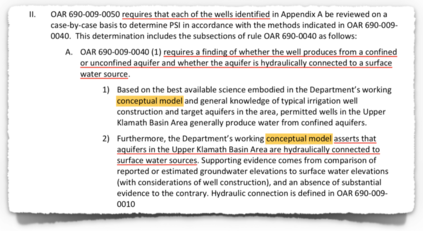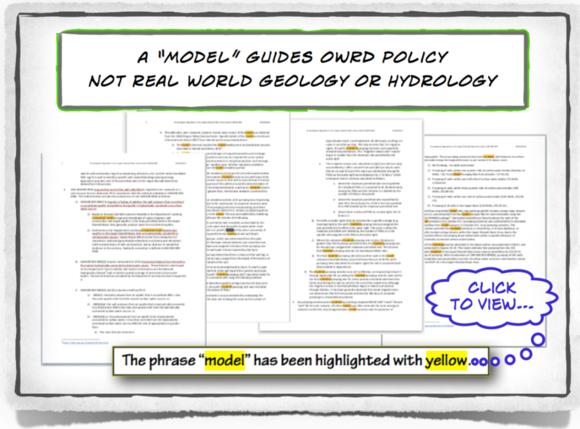|
Oregon Water Resources Department (OWRD) held several
meetings in the Klamath Basin last week explaining why they shut-off 140 irrigation wells in the Upper Klamath Basin. I was not able to
attend the several meetings that took place in Sprague River, Chiloquin and
Klamath Falls because of speaking engagements with Young Americans for Liberty
in Northern California.
Although I wasn’t there, believe me, I received a lot of
on-the-ground reporting from farmers, ranchers, and community members who were
in attendance.
For some background, water law and theory have long linked
ground water to surface water as described in, Arizona Law Where Ground and
Surface Water Meet, (1988),
“When water is pumped from an aquifer by means of a well, it
creates what is known as a ‘cone of depression.’ This is caused by the
groundwater in the aquifer moving toward the well. If the material in the aquifer has a high transmissivity value, the cone of depression will be wide and
shallow. If, on the other hand, the aquifer does not easily transmit water,
the cone of depression will be steep and narrow.
“If water is pumped
continuously from the well, the cone of depression will become larger. If the water table is close enough to
the earth's surface to allow this cone to cut into a surface stream, water from
the stream would directly infiltrate into the ground, following the slope of
the cone of depression until it reached the well. … This would cause less water
to be available in the stream bed.”
In Arizona law, the doctrine of prior appropriation
applies to surface waters and extends to another water category known as
“subflow.” Historically this is, "those waters which slowly find their way
through the sand and gravel constituting the bed of the stream, or the lands
under or immediately adjacent to the stream and are themselves a part of the
surface stream."
Now, this may be true in the sand and gravel of the
Arizona outback, it may even be true in the geological formations found within
the Upper Klamath Basin, but is it?
After all some wells are drilled through solid rock for
hundreds of feet while other wells are not. In other circumstances, a well,
even in close proximity to another, might travel through several different
aquifer layers before arriving at a separate hydrological zone that will meet
specific irrigation requirements.
However,
the facts on the ground, or in this case underground, don’t seem to matter to
OWRD. OWRD ought to answer one simple question, what impact does an individual
well have on a senior water right holder?
OWRD, understands the full implications of this policy
because they know people realize that every well might be different. Their
policy pretends to require individual well testing, as in OAR
690-009-0050. Their policy states each well must be, “reviewed on a case-by-case basis to determine PSI [potential
for substantial interference] in accordance with the methods indicated in OAR
690-009- 0040."
However, this case-by-case requirement gets completely passed-over
within the same OWRD policy because the model’s requirements are stranded upon a
blind-faith assertion. |
|
 |
The policy states, “the
Department’s working conceptual model asserts that aquifers in the Upper
Klamath Basin Area are hydraulically connected to surface water sources.”
Boom! There you have it. Game-over.
The assertion holds true because of …? Because of a
“conceptual model”?
Look at OWRD’s own Technical Memorandum on Groundwater
Regulation in the Upper Klamath Basin Area under OAR 690-009. Notice how many
times these rules rely on the “model” and how little respect is shown for scientific
data assessments. What techniques does OWRD use to review, verify and validate their
model so that the department can accept, reject or qualify collected data in an
objective and consistent manner. In other words, how is OWRD’s model confirmed
or validated? And, what would happen if their model was flawed?

In this current regulatory policy, OWRD is making the case
that across the entire Upper Klamath Basin watershed, all wells, at all times,
and in all circumstances, are hydrologically connected to surface water
sources.
My question is, who benefits from avoiding the use of scientific
rigor and precision when analyzing whether an existing groundwater
appropriation is hydrologically connected to surface water? Is this policy in
effect because of budgetary constraints? Is it in place due to other limited
resources, i.e., man-power limitations?
Science must be restored to its rightful place when weighing
the pros and cons of our state’s public policy when prioritizing the use of our
precious and scarce natural resources. First, OWRD ought to know with certainty
that an individual well is harming a senior water right-holder, before
shutting-off a specific water resource.
Second, OWRD needs to establish standards for measuring
distances between wells and surface water sources for the purpose of
determining the probability, or existence of surface water right impairment.
Third, OWRD also ought to provide negatively impacted
right-holders with written notice of planned actions so that families have time
to consider their available options.
Fourth, the models used, the facts gained, any legal theories
or existing rulings being used to support the planned action also need to be
made public.
If our government process is designed around public
participation and transparency, then publishing planned actions and detailed
evidentiary findings produced by a qualified hydrologist describing specific
well site geology and hydrology should not be a problem for our state
government’s executive agencies.
I am currently working on legislation that would require
OWRD to follow and adhere to these four suggestions. We must hold our unelected
bureaucracies to the highest bar possible when their rulings affect the very
lives and livelihoods of hardworking Oregonians.
Remember, if we don't stand for rural-Oregon values and common-sense – No one will!
Best Regards,
 Dennis Linthicum
Oregon State Senate 28
Capitol Phone: 503-986-1728
Capitol Address: 900 Court St. NE, S-305, Salem, Oregon 97301
Email: sen.DennisLinthicum@oregonlegislature.gov
Website: http://www.oregonlegislature.gov/linthicum
|